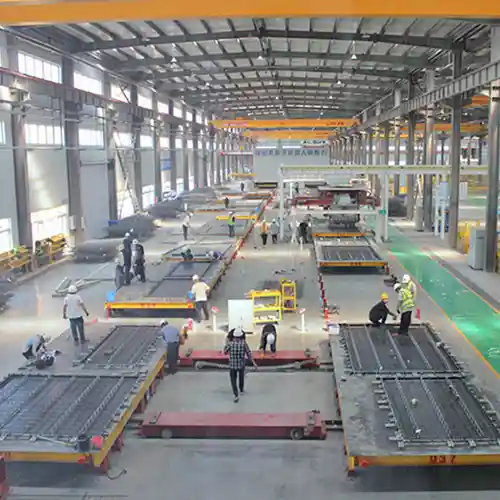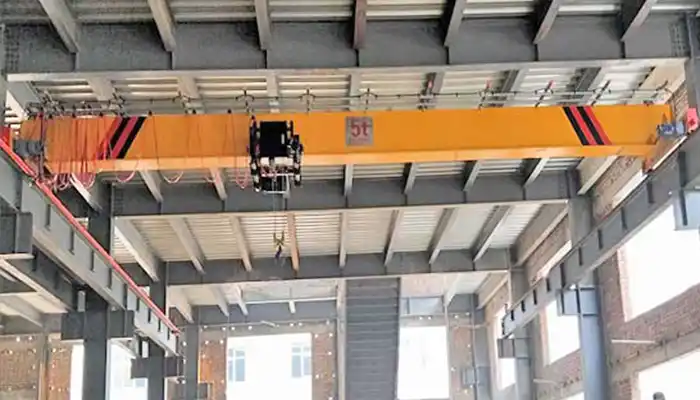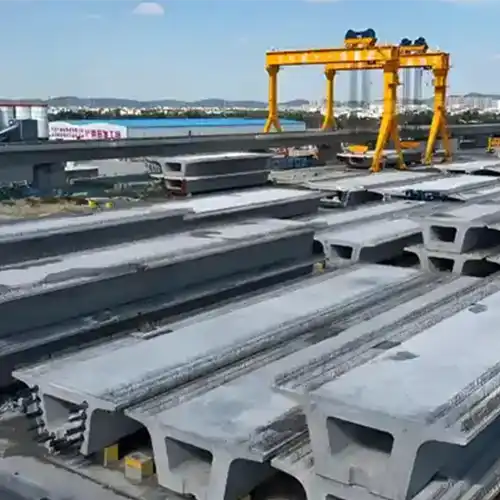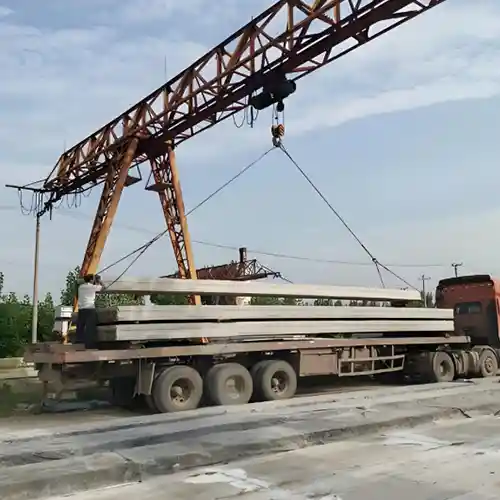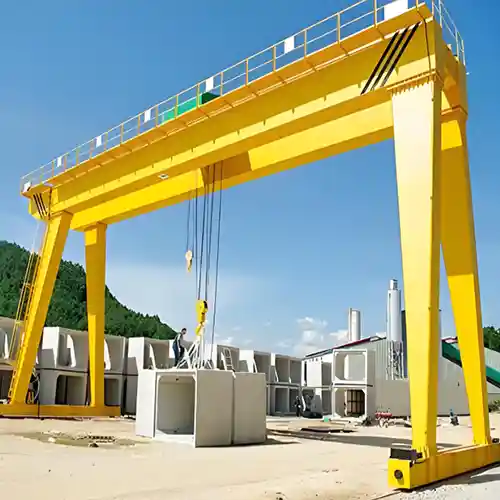Overhead Crane 3 Ton to 50 Ton for Mold Table Material Handling in Precasting
Enhance efficiency and precision in precasting plants with overhead cranes, expertly designed for mold table material handling, ensuring streamlined operations, durability, and superior load control.
Category: Construction
Your Trusted Overhead Crane Manufacturer & Supplier
Overhead Crane 3 Ton to 50 Ton for Mold Table Material Handling in Precasting
Enhance efficiency and precision in precasting plants with overhead cranes, expertly designed for mold table material handling, ensuring streamlined operations, durability, and superior load control.
Overview of Precasting Plants and Mold Tables
Precasting plants are specialized facilities where concrete components are manufactured off-site for use in construction projects such as buildings, bridges, tunnels, and other infrastructure. These plants produce a wide range of concrete products, including concrete panels, beams, columns, floor slabs, and other structural elements. The components are cast in molds, cured, and then transported to the construction site.
At the core of this process are mold tables. Mold tables provide a stable surface where molds are assembled and held during the casting and curing process. Depending on the specific requirements of the plant, mold tables come in various types, including fixed mold tables, assembly line mold tables, flip mold tables, and customized mold tables.
- Fixed mold tables are stationary and used to hold molds in place during the casting and curing stages.
- Assembly line mold tables are part of a continuous production line, allowing molds to move from one station to another for efficient production.
- Flip mold tables are designed to rotate molds to release cast components or facilitate multiple mold formations.
- Customized mold tables are designed for specific mold configurations, often for larger or unique precasting projects.
Mold tables are critical in ensuring the quality and consistency of precast products. Their design and functionality directly impact the efficiency of the plant, as they determine how quickly molds can be set up, used, and moved through the production process. Efficient mold table handling helps maintain a smooth workflow in the plant and reduces downtime.

Overhead crane for mold table material handling in precasting plant

Gantry crane for mold table material handling
The Need for Overhead Cranes in Mold Table Material Handling
Handling heavy mold tables is one of the most challenging tasks in a precasting plant. Mold tables can weigh several tons, depending on the size and the components they hold, making manual handling impractical and unsafe. Overhead cranes play a crucial role in lifting, positioning, and transporting these heavy mold tables within the plant.
Overhead cranes are used to move mold tables from one station to another, whether it's moving them from an assembly area to a curing station, flipping molds to release cast components, or placing molds into storage. Cranes provide several key advantages for these tasks:
- Heavy lifting: Overhead cranes are designed to lift very heavy loads, far beyond the capabilities of manual labor or other material handling equipment. Cranes ensure that molds can be handled safely and efficiently, reducing the risk of injury or equipment damage.
- Precision handling: In a precasting plant, molds often need to be positioned with high accuracy. Overhead cranes allow for precise movement and placement of mold tables, which is essential for tasks such as mold flipping or positioning molds in tight spaces.
- Space efficiency: Overhead cranes operate above the floor, freeing up valuable plant space for other activities. Unlike forklifts or other equipment that require space for movement on the ground, overhead cranes leave the floor area open for production tasks and other equipment.
Safety, precision, and efficiency are critical factors in selecting an overhead crane for mold table handling. Cranes must be capable of safely lifting the weight of the mold tables and providing smooth, controlled movements to avoid accidents or damage. In addition, the crane must be reliable enough to handle the demands of a high-volume production environment.
Overhead cranes also contribute to faster operations, improving plant productivity by quickly moving and positioning mold tables. This speed, combined with the precision and safety they offer, makes overhead cranes an essential part of any precasting plant.
In summary, overhead cranes are vital for mold table handling in precasting plants. They ensure that the process is carried out safely, efficiently, and with high precision, contributing to overall productivity and the smooth running of operations in the plant.
Types of Mold Tables in Precasting Plants
Fixed Mold Tables
- Description: Fixed mold tables are stationary platforms that hold molds during the casting and curing processes. They ensure molds stay in place while the concrete sets, often used for components like concrete panels and beams.
- Crane Role: Overhead cranes are essential for moving these heavy mold tables around the plant. They transport molds between curing stations, storage areas, or even the production line. Without cranes, handling these large molds would be nearly impossible.
- Crane Capacity: Typically, cranes used for fixed mold tables range from 5 to 15 tons. This range is enough to safely lift and move most standard molds used in precasting operations.
Assembly Line Mold Tables
- Description: These mold tables are part of a continuous production line. Designed for high-volume operations, they move molds quickly from one station to another, speeding up the overall production process.
- Crane Role: Cranes in assembly lines are vital for moving the mold tables between different workstations. They help keep everything running efficiently and on time, with minimal downtime between operations. It's all about speed and precision.
- Crane Capacity: For these fast-paced environments, cranes typically have a lifting capacity between 10 to 20 tons. This range ensures they can handle the medium-sized molds commonly used in high-volume production.
Flip Mold Tables
- Description: Flip mold tables are designed to rotate or "flip" molds to release the cast components or allow for multiple mold formations. This flipping process is essential for reducing manual labor and speeding up turnover time.
- Crane Role: Overhead cranes help lift and rotate the molds. These cranes are specially designed to support the weight of the mold while ensuring the flipping process happens smoothly. Imagine trying to flip a large, heavy mold manually—it would be a nightmare!
- Crane Capacity: Cranes that handle flip molds usually range from 15 to 30 tons, depending on the mold size and weight. These cranes are strong enough to handle the increased weight during the flipping process.
Customized Mold Tables
- Description: Customized mold tables are designed for specific projects that require unique molds. They are often used for larger or more intricate components, such as custom architectural elements or large structural beams.
- Crane Role: The cranes used for customized mold tables are tailored to the specific lifting needs of the molds. These cranes handle oversized or specially configured molds that can't be managed by standard equipment.
- Crane Capacity: The crane capacities for customized mold tables can vary widely. They usually range from 20 tons to 50 tons or more, depending on the complexity and size of the molds being used. Custom projects require custom solutions.
Mold tables come in various types, each serving a specific role in the precasting process. From fixed to custom-built tables, each one demands a crane with the right capacity to ensure smooth, safe handling. The key to a successful precasting operation lies in choosing the right crane for the job—one that matches the mold's weight, size, and complexity. After all, when it comes to heavy lifting, you need the right equipment to get the job done right!
Role of Overhead Cranes in Mold Table Material Handling
Single Girder Cranes:
Single girder cranes are ideal for handling smaller mold tables and lighter lifting tasks. With a simple design, consisting of one main girder, these cranes are an economical solution for smaller, less demanding lifting jobs. They are particularly useful in precasting plants where molds are relatively light, such as for smaller concrete panels or blocks.
Advantages:
- Cost-effective
- Requires less space
- Suitable for lighter lifting tasks (up to 10 tons)
- Efficient and quick for small-scale operations
Applications:
- Small to medium mold tables
- Lightweight components in precasting plants
- Low-to-medium volume operations
Double Girder Cranes:
Double girder cranes are specifically designed to handle larger, heavier mold tables and provide better stability and higher lifting capacities. These cranes feature two main girders, which offer superior strength and allow for more robust lifting operations, making them ideal for more demanding tasks. They are often used in larger precasting plants where molds can weigh significantly more and require increased lifting power.
Advantages:
- Higher load capacities (typically 10–50 tons)
- Increased stability for heavy and oversized molds
- Suitable for high-volume, large-scale production
Applications:
- Heavy-duty lifting tasks
- Large molds, flip molds, and complex components
- High-capacity precasting plants
Jib Cranes:
Jib cranes are more localized lifting machines that provide precise control over the movement of molds and components. They are often used in conjunction with overhead cranes for specific lifting tasks, such as placing molds into position or adjusting their position after a flip. Jib cranes are flexible and can be installed at workstations or along the production line to help with precise and limited-range movements.
Advantages:
- High precision and flexibility
- Useful for smaller, detailed lifting tasks
- Can be used to assist overhead cranes for added precision
Applications:
- Localized mold handling
- Fine adjustments in mold positioning
- Support for overhead crane operations in specific areas
Typical Crane Capacities
Light Duty Cranes (1–10 tons):
Light-duty cranes are used for smaller mold tables or lighter components. These cranes are ideal in precasting plants where molds are not large or overly heavy. Light-duty cranes help improve operational efficiency while minimizing costs by providing just the right amount of lifting capacity for everyday tasks.
Typical Use:
- Handling small to medium-sized molds
- Lightweight precasting components
- Ideal for small-scale or modular operations
Capacity Range: 1–10 tons
Medium Duty Cranes (10–20 tons):
Medium-duty cranes are used for multi-component molds or smaller fixed mold tables. These cranes can handle larger molds that require more lifting power but aren't as heavy as those found in high-capacity operations. They are typically used in plants with moderate production volumes.
Typical Use:
- Moving larger mold tables or multiple mold components
- Handling medium-sized fixed mold tables
- Suitable for plants with moderate-scale production and medium mold sizes
Capacity Range: 10–20 tons
Heavy Duty Cranes (20–50 tons):
Heavy-duty cranes are designed for larger, heavier mold tables, including flip molds or specialized molds with intricate designs. These cranes provide the required strength to lift heavy molds, ensuring that they are handled safely during the curing, storing, or transportation processes. Heavy-duty cranes are commonly found in high-volume plants where the demand for larger molds is constant.
Typical Use:
- Handling large molds or flip molds
- Lifting and moving heavy components within the plant
- Handling complex or oversized molds
Capacity Range: 20–50 tons
Extra Heavy Duty Cranes (50 tons and above):
For the most demanding precasting operations, extra-heavy-duty cranes are necessary. These cranes are capable of lifting oversized molds, heavy precast components, and performing complex lifting tasks. Large-scale plants or those involved in major infrastructure projects often require these cranes to handle the largest molds in the industry safely.
Typical Use:
- Handling the largest, heaviest molds
- Complex lifting operations with large molds and custom components
- Used in large-scale manufacturing plants or specialized precasting operations
Capacity Range: 50 tons and above
The role of overhead cranes in mold table material handling is critical to the smooth operation of a precasting plant. Choosing the right crane type and capacity is essential based on the size, weight, and complexity of the molds. Whether it's a simple single girder crane for smaller tasks, a double girder crane for heavy-duty lifting, or an extra-heavy-duty crane for the largest molds, the right equipment ensures efficiency, safety, and precision in every aspect of mold handling.
Factors Affecting Crane Capacity for Mold Table Handling
Mold Table Size and Weight
The size and weight of the mold table directly influence the crane's required capacity. Larger mold tables naturally demand more lifting power. Standard mold tables used in precasting plants can range from 5 tons for smaller molds to over 50 tons for larger and more complex molds.
- Smaller Mold Tables: Typically found in facilities with less demanding operations. These might weigh around 5 to 10 tons.
- Larger Mold Tables: Used for precasting large structural components, these mold tables can weigh 30 tons or more, requiring cranes with higher lifting capacities.
The greater the mold's weight, the higher the crane's load capacity needs to be. In addition, larger molds often require more space for handling, which might also require a crane with a longer reach or extended range.
Load Distribution
Irregular load distribution is a significant factor that affects crane capacity. Molds are not always evenly balanced, and their weight may be distributed unevenly, especially if the mold is asymmetrical or has concentrated areas of mass. This imbalance can affect the lifting dynamics, making the crane work harder and requiring additional support systems for safe lifting.
- Irregularly Shaped Molds: Molds with unusual shapes or those that are off-center may require spreader beams, lifting eyes, or other mechanisms to distribute the weight evenly and prevent tipping or shifting during lifting.
- Example: A mold table for a large structural precast component might weigh 25 tons, but its weight distribution is not uniform. In this case, the crane would need to have a capacity of 20–30 tons and might require a spreader beam to balance the load evenly.
This added complexity in load distribution can lead to the need for cranes with additional lifting support systems, which may also influence the crane's design and overall load-bearing capacity.
Lifting Height and Reach
The crane's required lifting height and reach are influenced by the plant's layout. Depending on how high the molds need to be lifted (e.g., from ground level to elevated storage or curing stations), the crane's stability and lifting capacity might need to be higher than the weight of the mold alone.
- High-Lift Operations: Cranes that need to lift molds to considerable heights, such as moving heavy molds to elevated curing racks or storage areas, must be designed for greater stability. This typically means the crane must have a higher load capacity than just the weight of the mold itself. A crane handling high lifts must maintain balance and avoid tipping under the weight, so more robust structures and designs are needed.
- Reach Consideration: Cranes with extended reach may need more powerful lifting systems to handle the same load at a distance. The further a crane has to extend its arm or boom, the more lifting power it needs to safely handle the mold at the extended range.
Thus, cranes used for high-lift operations are usually designed with higher load capacities and more rigid structures to ensure safe and effective handling.
Environmental and Operational Conditions
Crane performance is also influenced by the environmental conditions within the plant. Precasting plants often expose cranes to harsh conditions, such as extreme temperatures, high humidity, or even corrosive environments where chemicals are used.
- Corrosive Environments: In areas where molds are exposed to moisture, chemicals, or salt, such as coastal areas or chemical plants, cranes may require corrosion-resistant materials in their design. This extra requirement can add weight to the crane, affecting its load-bearing capacity. Stainless steel or coated materials may be used to reduce the effects of rust and corrosion, which in turn affects the crane's design and lifting capacity.
- Temperature Extremes: Extreme hot or cold environments can also influence the crane's load capacity, especially if it is required to work in freezing temperatures or high heat. Special lubrication and metal treatments may be needed to ensure smooth operation and prevent mechanical failure.
- High Humidity: Humidity can cause friction and wear in mechanical parts, affecting the crane's longevity and performance. Cranes designed for high-humidity environments often require enhanced seals and coatings, which might slightly reduce their overall capacity due to added weight.
In such cases, the crane's design and components need to be carefully selected to ensure that it can handle the environmental conditions without compromising on its lifting capabilities.
Several factors influence the crane's capacity for handling mold tables in precasting plants. Mold table size and weight are the primary considerations, but the distribution of the load, lifting height and reach, and environmental conditions also play significant roles. Understanding these factors allows for more accurate crane selection, ensuring that the right equipment is chosen for each unique molding and lifting requirement. Whether dealing with large, irregularly shaped molds or harsh plant environments, the crane must be carefully chosen to ensure safety, efficiency, and long-term performance.
Key Design Features for Overhead Cranes Handling Mold Tables
Double Girder Cranes
Double girder cranes are the go-to solution for heavy-duty mold table handling. Their design, featuring two parallel girders, offers excellent stability and higher load capacities compared to single girder models. This makes them ideal for lifting large, heavy molds used in precasting plants.
- Crane Capacity Range: Double girder cranes can handle a wide range of capacities, from 10 tons to more than 100 tons, depending on the size and complexity of the mold being handled. The added stability ensures that even the heaviest mold tables can be moved safely and efficiently.
Hoists and Trolleys
The hoist and trolley system is crucial for the smooth and precise movement of mold tables. Motorized hoists and trolleys provide accurate control over the lifting and positioning of molds, ensuring that the process is efficient and safe.
- Wire Rope Hoists: For handling heavier loads, typically ranging from 10 to 50 tons, wire rope hoists are used due to their strength and durability. These hoists are designed to manage the high loads and provide precise lifting capabilities for large molds.
- Chain Hoists: For lighter loads, chain hoists are often employed. These are suitable for molds weighing up to 10 tons and offer simplicity and reliability for less demanding tasks.
Precision Lifting Systems
For mold table handling, especially when working with large, heavy molds, precision is key. Several features are integrated into modern cranes to enhance lifting accuracy and control.
- Variable Speed Drives (VFDs): VFDs allow for variable lifting speeds, which is particularly useful when delicate or oversized molds are being moved. This feature ensures smooth acceleration and deceleration, reducing the risk of damage.
- Anti-Sway Technology: Anti-sway systems minimize the swinging or swaying of heavy loads, which is especially important in crowded plant environments where space may be limited. This ensures precise positioning and prevents accidents or damage to the molds.
- Load-Sensing Systems: These systems automatically adjust lifting speed and force based on the load, ensuring that the crane operates within its safe working limits and reduces wear and tear on both the crane and mold.
Anti-Corrosion and Custom Coatings
In many precasting plants, especially those near coastal areas or exposed to harsh conditions, anti-corrosion coatings are essential to protect crane components from degradation due to moisture, chemicals, or saltwater.
- Specialized Coatings: Cranes used in such environments are often fitted with specialized anti-corrosion coatings to extend their lifespan and reduce maintenance costs. These treatments can include galvanizing or the application of durable coatings to critical crane parts like hoists, trolleys, and rails.
- Example: A 30 ton crane used in an outdoor precasting plant near a coastal area may be coated with anti-corrosion treatments to protect it from the harsh marine environment, ensuring long-term durability and reliability with minimal maintenance.
The design features of overhead cranes used for handling mold tables are critical to ensuring safe, efficient, and precise operations in precasting plants. Double girder cranes provide the necessary lifting capacity and stability, while motorized hoists and trolleys ensure smooth handling of molds. Precision lifting systems enhance control, and anti-corrosion coatings protect cranes in harsh environments, ensuring long-term performance with minimal downtime. These features combine to make overhead cranes essential tools for mold table handling, increasing both productivity and safety in precasting operations.
Integration of Overhead Cranes with Mold Table Handling
Automating Mold Table Movements
The integration of automation systems with overhead cranes can revolutionize mold table handling in precasting plants. By automating the movement of mold tables, plants can significantly reduce the need for manual labor, decrease human error, and improve the overall efficiency of production processes.
- Benefits of Automation: Automated systems enhance precision in mold handling, ensuring that molds are moved consistently and accurately. This reduces the risk of accidents, minimizes downtime, and increases throughput by allowing for continuous operation without the need for manual intervention.
- Typical Capacity for Automated Systems: Automation is most commonly integrated with cranes that have a capacity in the range of 10–30 tons. These cranes are well-suited for handling molds with moderate weight and complexity while maintaining high precision in movement and positioning. The combination of automated control and these crane capacities optimizes the handling of mold tables in various stages of the production process.
Streamlining Production Workflows
Overhead cranes play a vital role in streamlining workflows within precasting plants. Integrating cranes with mold handling systems allows for seamless transitions between different stages of production, such as mold assembly, casting, and curing. This integration significantly improves production efficiency by reducing bottlenecks and ensuring that molds are consistently and quickly moved between workstations.
- Improved Workflow Efficiency: By connecting cranes directly to mold handling systems, plants can automate the process of moving molds between stations, reducing manual handling and minimizing downtime. This integrated approach ensures that molds are always ready for the next step in the production process, keeping the workflow continuous and smooth.
- Example: In a large precasting facility, a 20 ton overhead crane may be used to move mold tables from the assembly line to the curing station. With automated systems, this movement is done swiftly and accurately, reducing the need for manual labor and improving safety. The crane's precise control reduces the risk of mold damage during transport and ensures consistent, high-quality production.
The integration of overhead cranes with mold table handling systems is key to optimizing workflows in precasting plants. Automated systems help improve precision, reduce manual labor, and increase throughput. By automating mold movements, cranes contribute to seamless transitions between stages like assembly, casting, and curing, enhancing overall production efficiency. With the right capacity cranes—typically ranging from 10 to 30 tons—this integration not only boosts productivity but also improves safety and consistency in mold handling.
Case Studies and Real-World Applications
Case Study 1: Efficient Mold Table Handling in a Large Precasting Plant
In a large precasting plant specializing in concrete beams and panels, a 30 ton double girder crane was integrated into the mold table material handling process. The crane's primary role was to move heavy mold tables from the assembly area to the curing station, ensuring safe and precise handling of the molds throughout the production cycle.
- Challenges: The plant faced challenges related to heavy mold tables that needed to be moved across long distances within the plant. The molds were large and heavy, requiring precise positioning to ensure high-quality casting.
- Solution: The 30 ton double girder crane was chosen due to its ability to handle the substantial weight of the molds and its ability to cover large distances across the plant. The crane's design offered enhanced stability, reducing the risk of accidents and improving overall safety.
Impact on Efficiency:
- Increased Speed: The crane's high load capacity allowed for quicker handling and transportation of mold tables, reducing downtime and improving workflow.
- Improved Safety: With the heavier molds being handled more efficiently, the risk of injury was minimized, contributing to a safer working environment.
- Higher Throughput: The efficient handling of molds enabled faster transitions between production stages, boosting overall plant throughput.
This case demonstrates how a heavy-duty crane, such as the 30 ton double girder model, can significantly increase efficiency in precasting operations by offering improved load handling, safety, and speed.
Case Study 2: Automation in Mold Table Handling
A mid-sized precasting facility with a focus on producing precast concrete panels integrated automated overhead cranes into their mold table handling system. The cranes were equipped with automation systems, including variable speed drives (VFDs) and load-sensing technology, and had a lifting capacity in the 10–20 ton range.
Challenges: The plant struggled with manual labor costs and the inefficiencies of hand-operated cranes. Operators needed to manually move the mold tables between various stations, leading to longer cycle times and higher labor costs.
Solution: The installation of automated overhead cranes allowed for precise control of mold movements with minimal human intervention. The system was designed to move mold tables from assembly to curing stations without the need for manual lifting, reducing the reliance on operators.
Impact on Efficiency:
- Reduced Labor Costs: Automation significantly reduced the need for manual labor, leading to cost savings in staffing and training.
- Increased Precision and Speed: The automated system ensured that mold tables were handled with greater precision, reducing the risk of mold damage and improving the speed of production.
- Enhanced Workflow: The automated cranes seamlessly integrated with other parts of the production line, reducing delays and ensuring that molds were always at the right location at the right time.
This case study highlights the significant benefits of integrating automated systems into the mold table handling process, particularly for plants with moderate production volumes looking to reduce labor costs and improve operational efficiency. By automating the movement of mold tables, the facility was able to increase throughput while ensuring precise handling of molds and components.
Both case studies illustrate how overhead cranes, whether manual or automated, play a crucial role in optimizing mold table handling in precasting plants. The first case study demonstrates the importance of choosing the right crane type—such as the 30 ton double girder crane—for handling large, heavy mold tables with efficiency and safety. The second case study emphasizes the value of automation in improving mold handling times, reducing labor costs, and enhancing overall plant efficiency. These real-world applications provide valuable insights into the significant impact that properly selected and integrated overhead cranes can have on mold table material handling operations in precasting plants.
Conclusion
Selecting the right crane capacity for mold table handling is crucial to ensure safe, efficient, and precise operations in precasting plants. The capacity required depends on various factors, such as:
- Mold Size and Weight: Larger and heavier molds demand cranes with higher load capacities, typically ranging from 10 tons to 100 tons.
- Lifting Height: Cranes must be able to lift molds to the required heights, especially in high-lift applications like moving molds to elevated curing stations.
- Operational Conditions: Harsh environments, such as extreme temperatures or corrosive conditions, may require cranes with enhanced features like anti-corrosion coatings or custom designs to handle these challenges.
In typical applications, crane capacities range from 10 tons for lighter, smaller molds to 100 tons or more for oversized or specialized molds. For heavy-duty applications, custom crane solutions may be required, offering capacities that surpass the typical range.
In conclusion, the correct selection of crane capacity and the integration of new technologies will be key to optimizing mold table handling in precasting plants. As these systems continue to evolve, the industry can expect even greater levels of efficiency, precision, and safety in its operations.
Related Products

Latest project
150 Ton Overhead Crane Installation Feedback – Paraguay Case
QDX 150 ton overhead crane in action in Paraguay. Installation photos, video, and client feedback show performance, safety, and heavy-lifting efficiency.
Free consultation to Confirm Parameters & Specifications and Get
Latest Crane Price & Crane Rate.
- Types of overhead cranes : _______?
- Optional: Overhead travelling crane, goliath gantry crane,Slewing jib crane, Single girder or double girder crane,small portable crane or kbk crane, etc.
- Capacity of overhead crane: _______?
- Optional: 0.25ton, 0.5 ton, 1 ton, 2 ton, 3ton, 5 ton, 10 ton,15ton, 20ton, 25 ton, 30ton,35ton, up to 550ton, etc.
- Crane span & lifting height : _______?
- Crane travelling length : _____?
- Control of overhead crane:_______?
- Optional: pendant/ remote/cabin control
- Voltage supply of overhead crane:_____?
- Eg,: 380V50/60HZ,3Phase or others,etc.
- Application/usage of crane:_______?
- Eg,: Steel mill, ,injection mold, cement,stone, concrete,granite, general manufacturing, etc.
Just leave a message via the contact form and our hoist and crane engineer will contact you with in 24working hours.
Get In Touch
